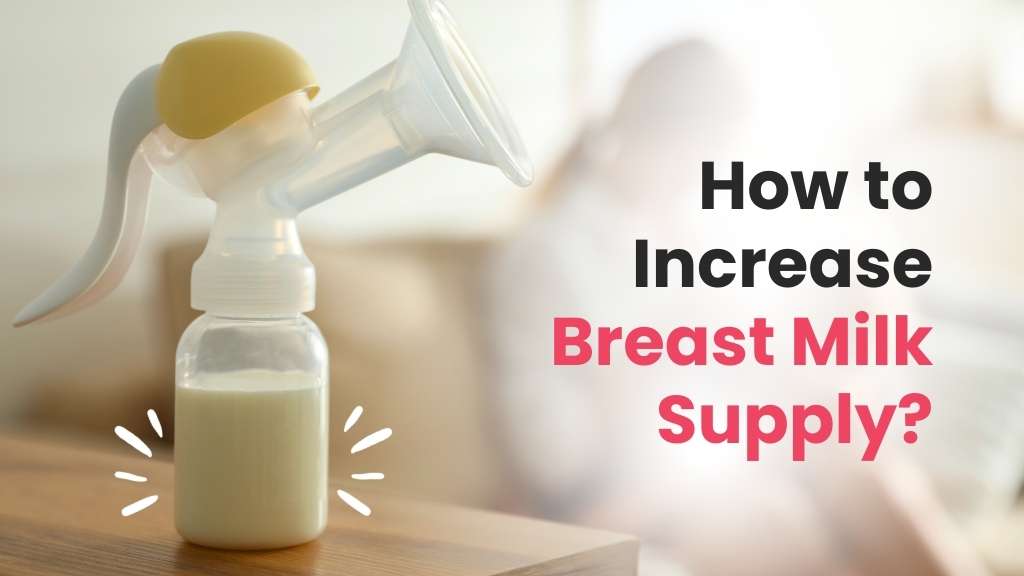
Table of Contents
Introduction: How To Increase Breast Milk Supply
Breast milk is often referred to as “liquid gold” for its unmatched nutritional benefits for newborns. However, many mothers may experience challenges with their milk supply. If you’re looking for how to increase breast milk supply, this comprehensive guide will provide you with valuable ways to increase breast milk supply naturally.
How To Increase Breast Milk Supply - Know The Ways!
1. Frequent and Effective Nursing
One of the most effective ways to increase breast milk supply is through frequent and effective nursing. The more often your baby latches and feeds, the more signals your body receives to produce milk. Ensure that your baby is latching correctly to encourage efficient milk removal.
2. Pumping Between Feedings
In addition to nursing, pumping between feedings can stimulate milk production. Use a quality breast pump to express milk after or between nursing sessions. This practice mimics the demand for milk and can help signal your body to produce more.
3. Stay Hydrated and Well-Nourished
Proper nutrition and hydration are essential for maintaining a healthy milk supply. Drink plenty of water throughout the day, and maintain a balanced diet rich in fruits, vegetables, whole grains, lean proteins, and healthy fats. Certain foods like oats, fenugreek, and fennel can be particularly helpful in boosting milk production.
4. Get Adequate Rest
Rest is crucial for milk production. Try to nap or rest when your baby does to ensure you’re well-rested. Stress and exhaustion can negatively impact milk supply, so prioritize self-care and relaxation.
5. Skin-to-skin contact
Skin-to-skin contact with your baby is not only beneficial for bonding but can also stimulate milk production. Holding your baby close and allowing them to root and nuzzle at your breast can encourage milk let-down.
6. Avoid Pacifiers and Bottles Early On
Using pacifiers and bottles in the early weeks can interfere with your baby’s ability to latch and stimulate your milk supply. It’s best to wait until breastfeeding is well-established before introducing these items.
7. Practice Breast Compression
While nursing, you can gently compress your breast to encourage milk flow. This can help your baby get more milk during each feeding and, in turn, signal your body to produce more.
8. Consider Herbal Supplements
Certain herbal supplements like fenugreek, blessed thistle, and milk thistle are known for their potential to boost milk supply. Consult with a healthcare professional before adding any supplements to your routine. Check out the breastfeeding diet plan here!
9. Galactagogues
Galactagogues are substances that promote milk production. Some commonly used galactagogues include oatmeal, brewer’s yeast, and lactation teas. Consult with a lactation consultant or healthcare provider before using them.
10. Seek Professional Support
If you’re struggling to increase your milk supply, consider consulting a lactation consultant or a healthcare provider. They can provide personalized guidance and address any underlying issues that may be affecting your milk production.
How Does Milk Production Work?
To get to the root of how to increase breast milk supply, one needs to understand how milk production works as well! Milk production, also known as lactation, is a complex biological process that occurs in the mammary glands of the breasts. Here’s a simplified overview of how milk production works:
- Hormonal Trigger: The process of milk production begins during pregnancy when hormonal changes trigger the development of mammary glands in the breasts. The primary hormones involved are estrogen and progesterone.
- Colostrum Production: In the later stages of pregnancy, the mammary glands start producing a thick, yellowish substance called colostrum. Colostrum is highly nutritious and rich in antibodies, providing essential nutrients and immune protection for the newborn.
- Birth and Placental Delivery: When a baby is born, the delivery of the placenta causes a drop in progesterone levels, which signals the body to begin producing more milk and transitioning from colostrum to mature milk.
- Prolactin Release: Prolactin, a hormone produced by the pituitary gland in the brain, plays a central role in milk production. It stimulates the mammary glands to produce milk. Prolactin levels rise in response to the baby’s sucking and emptying of the breasts.
- Milk Ejection Reflex (Let-Down): When a baby latches onto the breast and begins to suck, a neurohormonal reflex called the milk ejection reflex, or let-down, is triggered. This reflex releases stored milk from the milk-producing cells (alveoli) into the milk ducts. The hormone oxytocin is responsible for this reflex.
- Milk Production and Removal: As the baby continues to nurse, the breasts continuously produce milk to meet the baby’s demands. The more effectively the baby nurses and empties the breast, the more milk is produced in response. It’s a supply-and-demand system where milk production matches the baby’s needs.
- Composition of Milk: Breast milk is composed of water, carbohydrates (primarily lactose), proteins (including casein and whey), fats, vitamins, minerals, and antibodies. The composition can change to meet the baby’s nutritional needs as they grow.
- Feedback Mechanism: The process of milk production operates on a feedback mechanism. When the breasts are not adequately emptied, they signal the body to produce less milk as there won’t be any release of prolactin. But the more the baby feeds, the more prolactin will be released. This way milk production remains in balance with the baby’s needs.
- Weaning: When a mother decides to stop breastfeeding or when a child gradually weans from the breast, hormonal changes occur. Prolactin levels decrease, leading to a gradual reduction in milk production.
It’s important to note that each woman’s experience with milk production can vary, and factors like stress, medications, health conditions, and breastfeeding techniques can influence the process. Successful breastfeeding often involves proper latch and positioning, responsive feeding, and seeking support from lactation consultants or healthcare professionals when needed.
Risk Factors of Low Milk Supply
Low milk supply can be a concern for some breastfeeding mothers, and several risk factors may contribute to this issue. It’s essential to recognize these risk factors so that steps can be taken to address and mitigate them. Here are some common risk factors for low milk supply:
- Infrequent or ineffective breastfeeding: If a baby is not nursing frequently or not latching properly, it can lead to a decrease in milk supply. Frequent and effective nursing is crucial for maintaining milk production.
- Supplementing with formula: Introducing formula feeds in the early weeks can reduce the demand on the breasts, leading to a decreased milk supply. The more the baby nurses, the more milk is produced.
- Medical conditions: Certain medical conditions, such as polycystic ovary syndrome (PCOS), thyroid disorders, and hormonal imbalances, can affect milk production. Managing these conditions with medical guidance is essential.
- Breast surgery: Prior breast surgeries, including reductions or augmentations, may interfere with milk ducts or the ability to produce milk. However, some women can still breastfeed successfully after surgery.
- Stress and fatigue: High levels of stress, anxiety, and fatigue can negatively impact milk production. Adequate relaxation is important for maintaining a healthy milk supply.
- Medications: Some medications can suppress milk production. It’s important to consult with a healthcare provider before taking any medications while breastfeeding.
- Insufficient glandular tissue: In some cases, a woman may have insufficient glandular tissue in her breasts, which can limit milk production. This condition is relatively rare but may require supplementation with donor milk or formula.
- Hormonal birth control: Some forms of hormonal birth control, particularly those containing estrogen, can affect milk supply. It’s advisable to discuss birth control options with a healthcare provider when breastfeeding.
- Maternal smoking and alcohol consumption: Smoking and excessive alcohol intake can reduce milk supply. It’s best to minimize or avoid these substances while breastfeeding.
- Delayed breastfeeding initiation: A delay in initiating breastfeeding after birth can affect milk supply. Early and frequent breastfeeding in the first hours and days after delivery is essential.
- Inadequate calorie and fluid intake: A breastfeeding mother’s diet and hydration are critical. Insufficient calorie intake and dehydration can lead to decreased milk supply.
- Tongue-tie or other oral issues: Babies with tongue-tie or other oral issues may have difficulty latching and effectively removing milk from the breast, which can impact milk supply.
Addressing low milk supply often involves a combination of strategies, including increasing breastfeeding frequency, ensuring a proper latch, managing underlying medical conditions, seeking support from lactation consultants or healthcare providers, and maintaining overall maternal health and well-being. Every mother’s breastfeeding journey is unique, and it’s important to seek guidance and support when needed.
Conclusion
To increase breast milk supply can be a journey that requires patience and dedication. By following these tips and techniques, you can support your body in producing more milk for your baby. Every mother’s journey is unique, and it’s important to seek professional guidance when needed. With determination and the right support, you can provide your baby with the nourishing breast milk they need for healthy growth and development.










